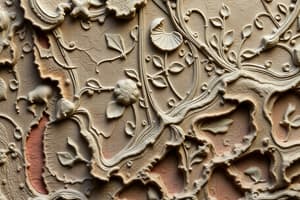Podcast
Questions and Answers
What are the Four Agents of Erosion?
What are the Four Agents of Erosion?
- Earthquakes, floods, tsunamis
- Gravity, running water, glaciers, wind (correct)
- Soil, rocks, minerals, heat
- Volcanoes, landslides, avalanches
Which of the following are examples of erosion?
Which of the following are examples of erosion?
- Mudslides and rills
- Both A and C (correct)
- Landslides and earthquakes
- Slump and creep
What is an example of mass movement caused by gravity?
What is an example of mass movement caused by gravity?
Slump
What is the process called that involves sediments moving slowly downhill due to repeated freezing and thawing?
What is the process called that involves sediments moving slowly downhill due to repeated freezing and thawing?
What is mudflow?
What is mudflow?
What is the term for the 'scar' left after water had run downhill?
What is the term for the 'scar' left after water had run downhill?
What do glaciated areas typically produce when glaciers melt?
What do glaciated areas typically produce when glaciers melt?
What are striations in relation to glaciers?
What are striations in relation to glaciers?
What does the term 'deflation' refer to in the context of wind erosion?
What does the term 'deflation' refer to in the context of wind erosion?
What is loess?
What is loess?
What are valley glaciers?
What are valley glaciers?
Flashcards are hidden until you start studying
Study Notes
Four Agents of Erosion
- Gravity: Causes mass movement through processes like slump, creep, rockslides, and mudflows.
- Running Water: Erodes land through rill/gully erosion, sheet erosion, and stream flow.
- Glaciers: Massive ice bodies that shape landscapes through glacial erosion and deposition.
- Wind: Erodes surface materials via deflation and abrasion, transporting fine particles.
Examples of Erosion
- Types include slump, creep, rockslides, mudslides, rills, gullies, deflation, and abrasion, each with unique characteristics and environmental conditions.
Agent: Gravity
- Mass Movement: Collective term for various forms of movement that gravity induces in earth materials.
Slump
- Occurs on steep slopes where underlying material weakens, resulting in a downward movement.
- Visible as a pile of sediments with an indentation at the slope's top.
Creep
- Gradual downhill movement of sediments, influenced by freeze-thaw cycles.
- Often results in tilted features like slanted fences.
Rockslides
- Rapid movement where rocks break loose and fall down slopes, leaving piles of debris at the base.
Mudflows
- Develop in dry areas when heavy, pasty mixtures of water and sediments flow downhill due to gravity.
Agent: Running Water
- Erosive force responsible for significant landscape changes through various forms of water movement.
Rill/Gully Erosion
- Rills: Small, temporary channels formed by water flow;
- Gullies: Larger, more permanent channels that leave scars on the landscape.
Sheet Erosion
- Occurs in flat terrain following rainfall, removing thin layers of topsoil uniformly across large areas.
Streams
- Moving water continuously transports sediments, depositing them downstream at river mouths, influencing landforms like deltas.
Alluvial Fan
- Triangular sediment deposit formed where a river spreads out and slows down, often resembling a sandbar.
Delta
- Specific type of alluvial fan located at the mouth of a river or stream, characterized by sediment deposition.
Agent: Glaciers
- Comprises large masses of ice that reshape the landscape through processes of erosion and deposition.
Valley Glaciers
- Smaller glaciers confined within mountainous valleys, moving slowly and eroding the landscape.
Continental Glaciers
- Vast ice sheets found in polar regions, capable of significant landscape alteration due to their immense size.
Glacial Erosion
- Similar to bulldozers, glaciers can transport vast amounts of material, eroding rocks through a scraping action.
Striations
- Scratches or grooves left on rock surfaces by glaciers, indicating the movement and direction of the ice flow.
Glacial Deposition
- Occurs as glaciers retreat and melt, leaving behind various sediments in the landscape.
Till
- Unsifted material deposited by glaciers, consisting of a mix of rock sizes and types.
Outwash
- Sorted gravel and sediment released from melting glaciers, typically found in channels over which meltwater flows.
Agent: Wind
- Plays a significant role in erosion, particularly in arid and semi-arid environments, through various mechanisms.
Deflation
- Process where wind removes fine particles, like sand, from the surface, leading to landscape changes.
Abrasion
- Wind-driven sediments erode surfaces similarly to sandpaper, smoothing and shaping materials.
Loess
- Deposits of fine, wind-eroded materials that accumulate into thick layers, often enhancing soil fertility in surrounding areas.
Studying That Suits You
Use AI to generate personalized quizzes and flashcards to suit your learning preferences.



